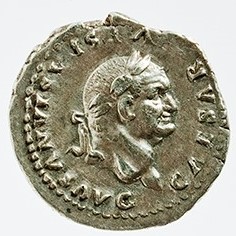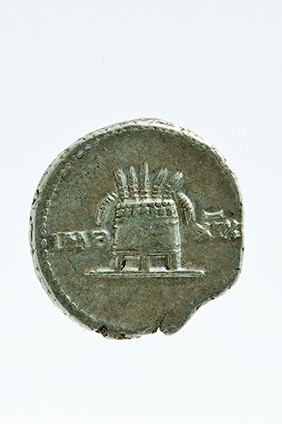Title: Denarius of Vespasian - 1991.02
Acquisition number: 1991.02
Author or editor: Beryl Rawson
Culture or period: Roman Imperial
Date: AD 77-78
Material: Metal - Silver
Object type: Coins - Roman
Dimensions: 19mm (w)
Origin region or location: Italy
Origin city: Rome
Display case or on loan: 7
Keywords: Coin, denarius, Roman, Imperial, Vespasian
Seaby, H.A., Roman Silver Coins (London, B.A. Seaby, 1967) II 980, 216; Mattingly, H.,Coins of the Roman Empire in the British Museum, 6 vols (London, 1965) 216.
1991.02
Denarius of Vespasian
3.59 g. AD 77-78
Obv.: Head of Vespasian, r., laureate. CAESAR VESPASIANVS AVG(ustus)
Rev.: Modius (grain measure) with ears of grain (5 + 2). In field, IMP(erator) XIX.
Vespasian, the fourth of the contenders to succeed Nero, won power in the latter half of AD 69 on the basis of his military strength (Judaean victories but also support from legions in other areas). He restored stability and established the Flavian dynasty which lasted until AD 96. He did not use the family name ‘Flauius’ on his coinage. He took on the title of ‘Augustus’ and the more personal family name of ‘Caesar’, to indicate continuity with the Julio-Claudian dynasty, although he had no family connection with that dynasty.
Throughout his reign (AD 69-79) his coinage advertised both military success and peace and prosperity. This coin does both. His salutation as ‘Imperator’ for the 19th time was for military successes in his name in AD 77 or 78. In AD 77 Trajan (father of the future emperor) received triumphal honours (ornamenta) for successes in Syria and Parthia, and in AD 78 Agricola was beginning his successful drive north and west into Britain. The symbols of modius (grain measure) and ears of grain proclaim agricultural prosperity and security of the grain supply.
Seaby, H.A., Roman Silver Coins (London, B.A. Seaby, 1967) II 980, 216; Mattingly, H.,Coins of the Roman Empire in the British Museum, 6 vols (London, 1965) 216.

